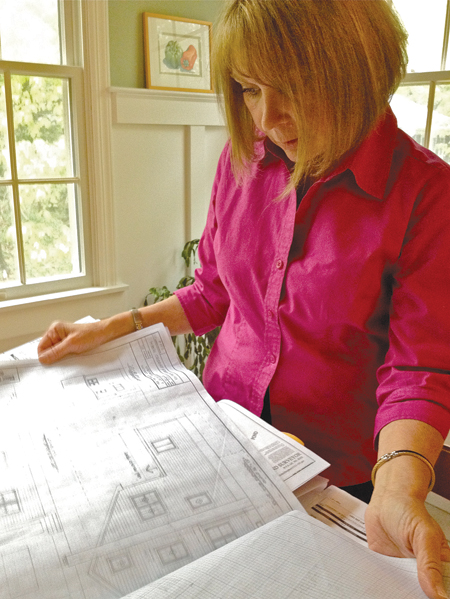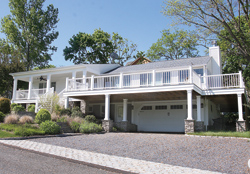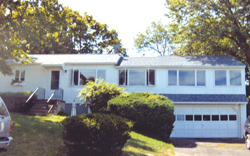Real Estate: She’s just not into designing ‘rich cribs’

Cutchogue designer and builder Eileen Santora is no rookie, and her work can’t be pigeonholed, except for this: She has absolutely no interest in being a designer to the rich and famous.
And she needn’t worry. Whether the job is adding a deck, redesigning a bathroom or doing a complete home makeover, Ms. Santora is not lacking for work. She’s currently on her 389th project, and her designs can be found all along the North Fork.
A self-proclaimed “middle-class designer,” her projects rarely cost more $200,000, and she tackles about one complete house per year, along with smaller projects. McMansions, though, just aren’t her thing.
“I’m not the Hamptons or the 3,000-square-foot house designer,” she said, “I’m the middle-class architect and, out here, I cater to people who have two homes. If they’re middle-class, they might be able to afford the job but not to pay taxes on the house for the next 50 years, so a conversation has to take place to find out not only what they want but what they can afford.”

Granite countertops are a splurge for some folks, which Ms. Santora said she, as someone with a fabricated countertop herself, understands. When expensive countertop materials strain the budget, she said, she tells the client, “That’s fine, there’s some beautiful laminate we can use.”
She said working for construction companies in the past taught her a lot about building on a budget.

“It also taught me not to just design a house on paper but also build it on paper. I design it thinking, ‘How am I going to make this structure fly?’ Some architects draw pretty pictures that can never be built.”
Ms. Santora’s first step in any project is to visit the client and get to know the family and their lifestyle, a step she said is essential because every client’s needs and desires are different. Because of this, she said, each of her homes has a unique look.
“You can’t look at a house and say, ‘That’s an Eileen Santora,’ ” she said.
If there were an Eileen Santora signature, she said, it would include big closets, kitchens that “work” and well-designed bathrooms.
“I like to open up the space in a home so that all of it is used and functional for today’s lifestyle,” she said. “In older homes rooms are all little boxes and living rooms were to be looked at, not messed up. People want to ‘live’ in their living rooms and be comfortable in their homes these days.”
With a summer home, she said, she focuses on bringing the outdoors into the house, which means adding decks and front porches. For those who live here year-round, it’s about adding a fireplace or an alternative heat source.
“I build a fireplace or another heat source in about every house I build because not everyone can afford a generator,” she said.
With older homes, Ms. Santora said, she becomes a detective, sniffing out clues to what that house looked like in its heyday, Many times, the investigation leads to returning to the original molding or reconstructing a removed front porch.
She researches older homes through town or local historical societies and locates the property card for the house’s original build date.
“I love it,” she said. “You can rip out a toilet and think to yourself, ‘This is a 1950s remodel and here’s a toilet from ’43.’ ”
The process has netted her a wide variety of cool finds. She’s discovered old newspapers and beer cans in walls and once found an arrow drawn on the wall, pointing to a nail, with the word: “Last nail in the house.”
In a New Suffolk project, when it came time to open the walls, she found the home was insulated entirely by bricks.
Ms. Santora hand-draws all her designs, so forget those fancy-schmancy high-tech computer design programs that some architects employ.
“I say to my customers, ‘When you’re planning a wedding, would you rather have a band or electronic music?’ That usually puts it into perspective for them,” she said.
She’s currently finishing up the transformation of a three-bedroom bungalow in Reeves Park, Riverhead, into a six-bedroom house. That project that will come to an end this Memorial Day.
She started out at Southampton College, where she said she fell in love with the East End, but returned to East Meadow, where she grew up, to attend Hofstra as an art student. She then moved on to interior design, graduating from the New York School of Interior Design in 1974.
At that time, she was working for Norman Harvey, a company that decorated model homes. During her stint there, she realized she didn’t want to decorate houses, she wanted to build them.
Ms. Santora attended Nassau Community College’s civil engineering technology program and graduated with a degree in architectural technology from SUNY/Empire College in 1986.
Getting there was no easy feat, she said, and opposition was around every corner.
“There weren’t many women in the field at that time,” she said, recalling a night class on the study of structure and strength, where she, the lone woman among about 27 students, was picked out by the professor and asked why she wasn’t “home coloring Easter eggs” with her family.
“I was horrified,” she said, “I just kept quiet as the men around me chuckled.”






